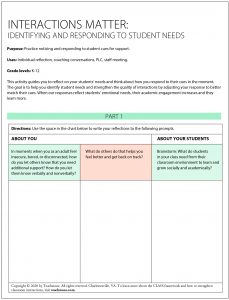TOOLS
Teacher as noticer
By Yvonne Godber
Categories: Coaching, Social & emotional learningJune 2020
Vol. 41, No. 3
Improving educators’ abilities to recognize and respond to signals that indicate students are upset, confused, or disengaged is a powerful but often underused strategy for ensuring that all students are accessing rigorous learning. Research has shown that when adults respond to students’ social and behavioral cues for help in a timely, proactive, and sensitive matter, students are more able to get back on track with important learning tasks at hand. Such supportive responses have been linked to increases in student achievement, peer relationships, and engagement, and decreases in exclusionary disciplinary practices (Gregory et al., 2016), all of which can help schools achieve important equity goals.
Research has shown that when adults respond to students’ social and behavioral cues for help in a timely, proactive, and sensitive matter, students are more able to get back on track with important learning tasks at hand. Share on XAre you and your colleagues prepared to recognize and meet all students’ needs?
Teachstone, a company using education technology to improve the ways teachers interact with students, has developed practical tools that can help teachers notice and respond more quickly and effectively to student academic and social-emotional cues. The tools are grounded in the Classroom Assessment Scoring System (CLASS), a framework underlying teacher professional learning models that grew out of research conducted at the University of Virginia. CLASS is an evidence-based method for measuring, evaluating, and improving teacher-student interactions that helps teachers cultivate supportive, structured, and engaging experiences for children and adolescents from birth through high school.
CLASS pulls out and measures complex classroom interactions as the key determiner of students’ social, emotional, and academic outcomes. The framework describes how students benefit when they:
- Feel emotionally connected to adults and peers (connection);
- Understand the organization and routines of their environment (organization); and
- Are appropriately challenged, engaged, and curious (challenge).
One aspect of the CLASS framework identifies specifically how adults and peers cultivate warm and supportive relationships with one another. The ways adults and peers respond to a student who struggles in some way (academically, socially, developmentally, behaviorally, emotionally) influence whether that student is able to get back on track to the task of learning or, instead, his or her issue escalates and interferes with his or her ability to grow and learn socially or academically. In other words, responsiveness matters.
Why do we need to assess interactions?
Classrooms are busy places. Planning and implementing thoughtful learning experiences is challenging, even without simultaneously watching student responses and cues to make sure students are really benefiting from the intended strategy. Yet those responses are essential for the carefully planned lesson to succeed as planned. Even though a pilot sets a flight plan before taking off, adjustments occur in flight, based on weather, traffic, plane functioning, or passenger needs. Similarly, even the best planned lesson can get off course if adults are not aware of and responding to the many diverse needs students bring with them each day.

At times, students manage to get the help they need on their own by using their own skills, peers, and developmental resources. At other times, though, they rely on adults to notice and attend to their needs to get back to the task of learning and the instructional activities planned for them.
Without a doubt, observant and supportive teacher practices are required for students’ engagement and ability to learn, benefit from, and contribute to instructional content. Luckily — with support, feedback, and practice — these are skills that teachers can learn to refine while enhancing responses to better match student emotional needs and get students back to the important learning goals at hand.
Without a doubt, observant and supportive teacher practices are required for students’ engagement and ability to learn, benefit from, and contribute to instructional content. Share on XActivity description
Teachstone created the following professional learning activity to encourage teacher reflection and support adult awareness of and responsiveness to students’ needs and cues.
This resource is designed to be used independently or in conjunction with other social and emotional learning (SEL) professional learning strategies that address SEL and teacher-student relationships. It can be used in many different ways, depending on the teacher and contextual needs. For instance:
- Individual reflection and planning;
- Promoting a coaching conversation;
- A guide for professional learning community discussions; and
- Larger staff meetings.
The objectives of this activity are to help teachers:
- Reflect on how students let those around them know that they require additional support to meet their academic, behavioral, developmental, or social-emotional needs;
- Practice identifying both student cues and teacher responses; and
- Plan for more effective, sensitive, and timely responses to student cues.
The activity includes two sections: Part 1: Part 1 asks teachers to reflect on how their students demonstrate various academic or social-emotional needs and recollect specific scenarios in their classrooms to describe how they responded to these needs at the time.
If used in conjunction with one-on-one coaching, a PLC, or a staff meeting, Part 1 can be completed ahead of time in preparation for a shared conversation.
Part 2: Part 2 includes several brief online video clips of real classroom footage at different age levels. Teachers follow a link to a web page to view a clip of their choice where they identify student cues that they need some type of help or support and the degree to which the teacher responded in a way that supported students’ academic, behavioral, or social-emotional growth.
Part 2 can also be completed individually or as part of a group learning experience.
The activity ends with a reflection on why sensitive and timely responses are important to student development, along with goal planning to increase the quality of timely and sensitive responses.
Coaching project for middle and high school teachers
Learning Forward, Teachstone, and American Institutes for Research are collaborating on a federally funded Education Innovation Research grant to refine and scale a validated, strength-based supplemental coaching program for middle and high school teachers based on the Classroom Assessment Scoring System (CLASS). For further information visit www.secondarycoaching.org.
Early validation research on this program, the MyTeachingPartner (MTP) 1:1 Video Coaching Model for teachers, showed a nine-point achievement gain for secondary students (50th to 59th percentile), and the model has been recognized in the What Works Clearinghouse (Allen et al., 2011).
References
Allen, J.P., Pianta, R.C., Gregory, A., Mikami, A.Y., & Lun, J. (2011). An interaction-based approach to enhancing secondary school instruction and student achievement. Science, 333, 1034-1037.
Gregory, A., Hafen, C.A., Ruzek, E., Mikami, A.Y., Allen, J.P., & Pianta, R.C. (2016). Closing the racial discipline gap in classrooms by changing teacher practice. School Psychology Review, 45(2), 171-191.
Categories: Coaching, Social & emotional learning
Recent Issues
LEARNING DESIGNS
February 2025
How we learn influences what we learn. This issue shares essential...
BUILDING BRIDGES
December 2024
Students benefit when educators bridge the continuum of professional...
CURRICULUM-BASED PROFESSIONAL LEARNING
October 2024
High-quality curriculum requires skilled educators to put it into...
LEARNING TO PIVOT
August 2024
Sometimes new information and situations call for major change. This issue...












